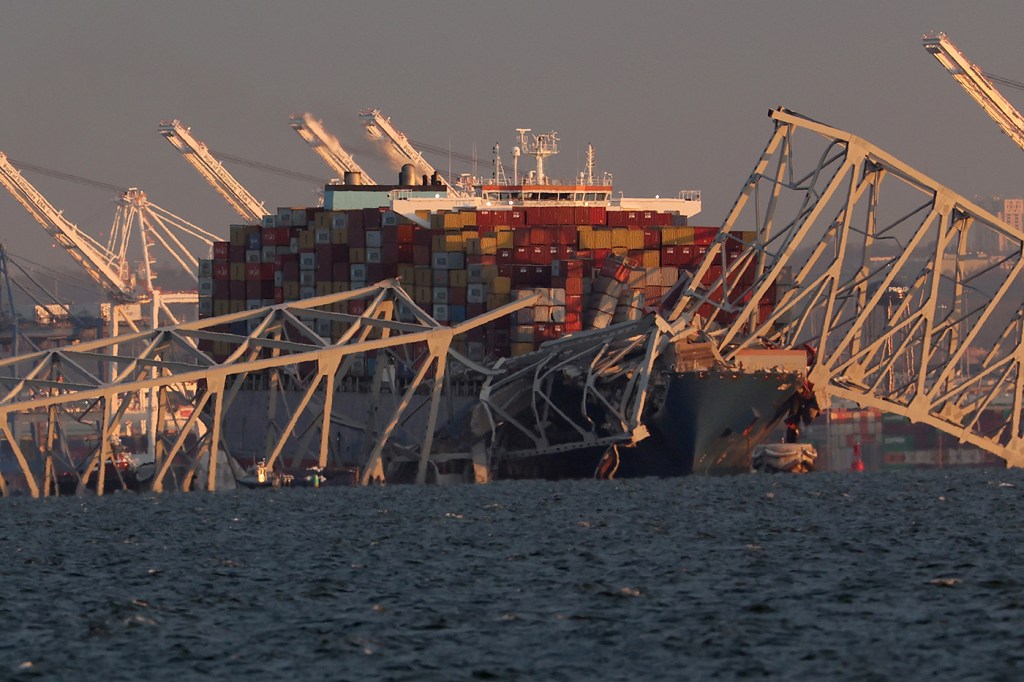What contributed to the Baltimore Bridge collapse
The early morning of March 26th, 2024, saw a major tragedy unfold in Baltimore, Maryland. The Francis Scott Key Bridge, a vital artery connecting the city across the Patapsco River, succumbed to a catastrophic collapse. A rogue container ship, the MV Dali, slammed into a support pillar, sending a section of the bridge plummeting into the frigid waters below.  While the cause seems clear-cut – a ship collision – a closer look reveals a complex interplay of factors that contributed to this devastating event.
While the cause seems clear-cut – a ship collision – a closer look reveals a complex interplay of factors that contributed to this devastating event.
What contributed to the Baltimore Bridge collapse
The Immediate Cause
The undisputed trigger for the collapse was the impact of the MV Dali. The 1,000-foot long behemoth, laden with cargo containers, lost power and drifted into the bridge. The force of the collision, estimated to be in the millions of pounds, heavily damaged a critical support pier. This initial breach compromised the structural integrity of the bridge, leading to a cascading failure as the weight distribution became unbalanced.
The National Transportation Safety Board (NTSB) investigation is ongoing, but preliminary reports suggest several areas of concern with the ship's operation. One possibility is a mechanical failure that rendered the vessel powerless and unable to steer. Another theory centers on human error, investigating if there were any lapses in judgment or navigational mistakes by the crew.
Underlying Issues: Ageing Infrastructure and Potential Design Shortcomings
While the ship collision was the immediate cause, the bridge's vulnerability raises questions about its overall health. The Francis Scott Key Bridge, opened in 1977, was nearing its 50th year. Regular inspections are crucial for aging infrastructure, but concerns have been raised about the adequacy of maintenance in recent years.
Furthermore, the bridge's design itself is under scrutiny. Experts point to the potential mismatch between the bridge's original load capacity and the ever-increasing weight and size of modern cargo ships. The bridge may not have been designed to withstand the impact of such a massive vessel.
The NTSB will be analyzing these factors, including the bridge's construction materials, stress calculations, and any known deterioration of the support structures. A thorough evaluation of the existing design specifications will be crucial in determining if the bridge could have been better equipped to handle such an impact.
The Human Cost: Worker Safety and Rescue Efforts
The human cost of the collapse is the most profound tragedy. Six construction workers who were on the bridge for overnight maintenance were presumed dead. The immediate aftermath focused on search and rescue efforts, with divers braving the murky depths of the Patapsco River in a race against time.
This incident highlights the importance of prioritizing worker safety during bridge maintenance. Strict protocols regarding work hours, visibility conditions, and communication with maritime traffic are essential to minimize risks. The NTSB investigation will likely scrutinize the safety procedures in place and assess if all precautions were taken to protect the workers.
The Economic Impact: A City Divided
The collapse of the Francis Scott Key Bridge severed a vital transportation link, disrupting the flow of goods and services within Baltimore. Commuters faced longer travel times, businesses experienced delays in deliveries, and the overall economic activity in the city was significantly impacted.
The financial repercussions are still being calculated, but early estimates suggest the cost will run into the billions of dollars. The reconstruction of the bridge, the lost productivity due to transportation disruptions, and the potential environmental damage from the debris in the river all contribute to the economic burden.
Lessons Learned and Rebuilding Baltimore
The Baltimore bridge collapse serves as a stark reminder of the importance of infrastructure maintenance, bridge design considerations in the face of evolving maritime traffic, and prioritizing worker safety. The NTSB investigation will provide crucial recommendations to prevent similar tragedies in the future.
The city of Baltimore now faces the daunting task of rebuilding the bridge. The reconstruction effort will need to be efficient and transparent, minimizing further economic disruption. The new bridge design should incorporate lessons learned from the collapse, ensuring it can withstand the rigors of modern shipping traffic for decades to come.










































